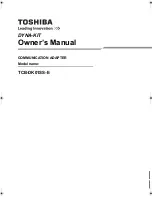
Configuring Security, Quality, and Network Features
Ensuring Voice Quality
Cisco SPA and Wireless IP Phone Administration Guide
119
6
The administrator can select the low-bit-rate codec used for each line. G.711a and
G.711u are always enabled. The following table shows the codecs supported by
Cisco IP phones. The third column shows the voice quality Mean Opinion Score
(MOS), with a scale of 1–5, in which higher is better.
Codec (Voice
Compression
Algorithm)
Complexity and Description
MOS Score
G.711 (A-law
and u-law)
Very low complexity. Supports uncompressed 64
kbps digitized voice transmission at one through ten 5
ms voice frames per packet. This codec provides the
highest voice quality and uses the most bandwidth of
any of the available codecs.
4.5
Highest
voice quality
G.726
Low complexity. Supports compressed 16, 24, 32, and
40 kbps digitized voice transmission at one through
ten 10 ms voice frames per packet. When no static
payload value is assigned per RFC 1890, Cisco IP
phones can support dynamic payloads for G.726.
NOTE
G.726 is supported only for 32kbps on the
SPA525G.
4.1 (32 kbps)
G.729 and
G.729A
G.729A low-medium complexity. G.729 medium
complexity.
G.729A requires about half the processing power of
G.729. The G.729 and G.729A bit streams are
compatible and interoperable, but not identical.
4
G.723.1
High complexity. Cisco IP phones support the use of
ITU G.723.1 audio codec at 6.4 kbps. Up to two
channels of G.723.1 can be used simultaneously. For
example, Line 1 and Line 2 can be using G.723.1
simultaneously, or Line 1 or Line 2 can initiate a three-
way conference with both call legs using G.723.1.
NOTE
G.723.1 is not supported on the 525G or
WIP310.
3.8
G.722
Supported on the SPA525G only. Only one G.722 call
at a time is allowed. If a conference call is placed, a
SIP re-invite message is sent to switch the calls to
narrowband audio.
4.3 (approx)
















































